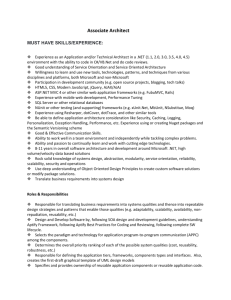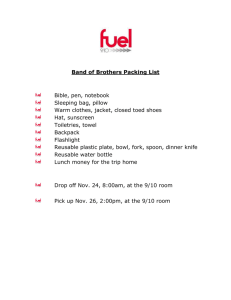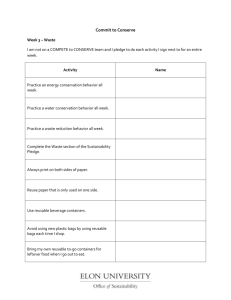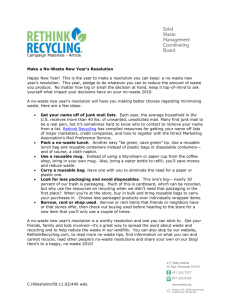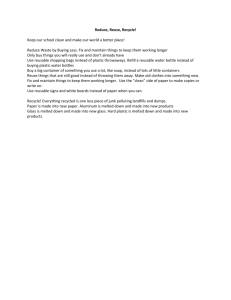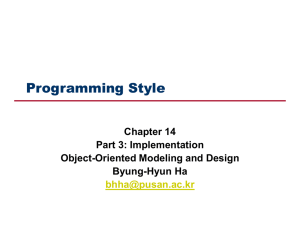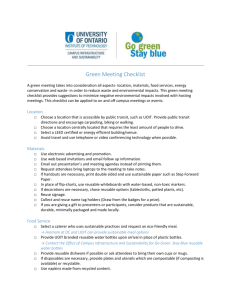Issues of the Reusability of Learning Objects in E
advertisement
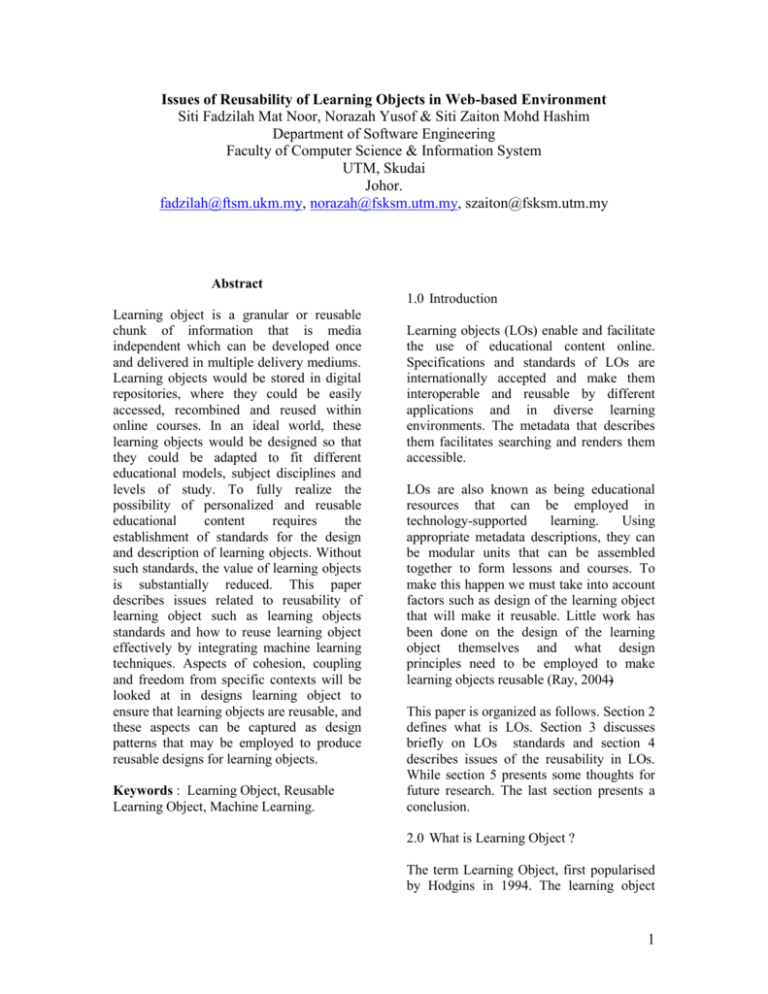
Issues of Reusability of Learning Objects in Web-based Environment Siti Fadzilah Mat Noor, Norazah Yusof & Siti Zaiton Mohd Hashim Department of Software Engineering Faculty of Computer Science & Information System UTM, Skudai Johor. fadzilah@ftsm.ukm.my, norazah@fsksm.utm.my, szaiton@fsksm.utm.my Abstract 1.0 Introduction Learning object is a granular or reusable chunk of information that is media independent which can be developed once and delivered in multiple delivery mediums. Learning objects would be stored in digital repositories, where they could be easily accessed, recombined and reused within online courses. In an ideal world, these learning objects would be designed so that they could be adapted to fit different educational models, subject disciplines and levels of study. To fully realize the possibility of personalized and reusable educational content requires the establishment of standards for the design and description of learning objects. Without such standards, the value of learning objects is substantially reduced. This paper describes issues related to reusability of learning object such as learning objects standards and how to reuse learning object effectively by integrating machine learning techniques. Aspects of cohesion, coupling and freedom from specific contexts will be looked at in designs learning object to ensure that learning objects are reusable, and these aspects can be captured as design patterns that may be employed to produce reusable designs for learning objects. Keywords : Learning Object, Reusable Learning Object, Machine Learning. Learning objects (LOs) enable and facilitate the use of educational content online. Specifications and standards of LOs are internationally accepted and make them interoperable and reusable by different applications and in diverse learning environments. The metadata that describes them facilitates searching and renders them accessible. LOs are also known as being educational resources that can be employed in technology-supported learning. Using appropriate metadata descriptions, they can be modular units that can be assembled together to form lessons and courses. To make this happen we must take into account factors such as design of the learning object that will make it reusable. Little work has been done on the design of the learning object themselves and what design principles need to be employed to make learning objects reusable (Ray, 2004) This paper is organized as follows. Section 2 defines what is LOs. Section 3 discusses briefly on LOs standards and section 4 describes issues of the reusability in LOs. While section 5 presents some thoughts for future research. The last section presents a conclusion. 2.0 What is Learning Object ? The term Learning Object, first popularised by Hodgins in 1994. The learning object 1 (LO) model is based on the belief that we can create independent and self-contained chunks of educational content which may be used alone or dynamically assembled to provide “just enough” or “just-in-time” learning. On top of that, these instructional components can be combined to form longer educational interactions or reused in different learning contexts. Wiley (2001) defines Learning Objects are likened to atoms: they are made up of smaller pieces which by themselves are not as useful as the whole; they can be combined, but only in certain ways (atoms can only join with certain other atoms, not with any atom that happens along); and they form compounds which can then be combined or deconstructed again. Another perspective compares learning objects to LEGO building blocks: small units that can be fitted together and number of ways to produce customized learning experiences (Hodgins & Conner, 2000). New Media Consortium (NMC) defined LO is any grouping of materials that is structured in a meaningful way and is tied to an educational objective (Johnson, 2003 in Rachel 2004). The ‘material’ in a learning object can be documents, pictures, simulations, movies and sound. Structuring these in a meaningful way implies that the materials are related and are arranged in a logical order. But without a clear and measurable educational objective, the collection remains just collection (Rachel, 2004). According to Mohan and Greer (2003), a learning object is a digital learning resource that facilitates a single learning objective and which maybe reused in a different context. From these definitions, it is clear that ‘learning objects’ are small chunks of learning content (to achieve specific learning objective) which can be reused to create another course or sequenced to form individual learning paths. 3.0 LOs standards The goal of standards is to provide fixed data structures and communication protocols for LOs and cross-system workflows. This enables interoperability between application, such as an Learning Management System (LMS) or in-house developed content, by providing uniform communication guidelines that can be used throughout the design, development and delivery of LOs. There have been a number of efforts worldwide to develop standards for learning object interoperability (Friesen & McGreal , 2002). Based on Macromedia survey of corporate and government eLearning developers, a convincing 93% said that standards were either “very important” or important. This emphasizes how critical it is to understand the value of standards, and the challenges faced by developers in changing their design and implementation models in support of standards. (Heins & Himes, 2002). According to an industry report by the Masie Center 2002 (Heins & Himes, 2002) , eLearning standards are of value in that they support investments in: Interoperability, defined as interchangeability. Durability, defined as having lasting value. Manageability, defined by enabling value to be assessed. Re-usability, defined as usage in different contextual situations. Accessibility, defined as access to content for individuals with disabilities. These standards focus on content metadata, content packaging, and run-time communication to support tracking of student activities. All of the standards are predicated upon the notion of a reusable Learning Object. 2 To this end, there are also several organizations working toward standards to get content labeled in a consistent way (using XML language and metadata which is like a bar-coding system) and to make sure learning content is ‘interoperable’ with various learning management technologies. Organizations developing standards for learning objects include the Instructional Management System Global Consortium (IMS), the Institute for Electrical and Electronic Engineers/Learning Technology Standards Committee (IEEE/LTCS) and the Aviation Industry CBT Committee (AICC). As an example, the IMS develops and promotes open specifications for facilitating online distributed learning activities such as locating and using educational content, tracking learners’ progress, reporting learner performance, and exchanging student records between administrative systems. 4.0 Issues of the Reusability in Learning Objects. Reusable Learning Object (RLO) or Shared Content Objects (SCO) according to the SCORM terminology represents an alternative approach to content development (Reusable Learning Object Strategy Definition, 2000). RLO is any digital resource that can be reused to support Webbased learning. RLO's can be lesson plans, case studies, quizzes, simulations, or interactions. These objects are stored in a database and briefly described using MetaData. MetaData is information about the learning object. MetaData can be the name of the author, the instructional approach used, or the learning objective it works to fulfill. RLO's allow designers to create content once, store the content in a database using MetaData and deliver the content in many different structures. (Encylopedia of Educational Technology ,2006). objects can be re-assembled to create new courses or sequenced to form individual learning paths. Based on Valderama et al 2005, the key issues in RLO are: each RLO must be able to communicate with learning systems using a standardized method that does not depend on the system. a sequencing system (usually forming a part of the LMS) defines the navigation rules for a learner to move between RLOs, each RLO has a description that enables designers to search for and find the right RLO for the right job. This can give benefits to users as it will enables mass-customization of learning with more personalized and ‘just for me’ content. And for authors, there is the opportunity to search for existing learning objects from within the organization or from external providers and reuse them, saving time and money. Issues on the design of learning object is also important in order to develop reusable learning object. Based on software engineering principles, ‘coupling’ and ‘cohesion’ were an important factors in the design of a learning object (Boyle, 2003). Coupling refers to the level of independence of a learning object. A learning object should, ideally, not have dependencies on other learning objects: it should be "an independent and self-standing unit of learning content" (Polsani 2003). A cohesive learning object is one that is single-minded: it is concerned with only with one thing (e.g. a single learning objective or aim). By maximising cohesion and minimising coupling we adhere to the software engineering principles for the modularisation of software (Pressman 2004). From a pedagogical perspective, each RLO might play a specific role within an instructional design methodology. Learning 3 A further factor to be taken into account is that of context. The reuse of a learning object implies usefulness within different contexts. For example, a learning object that is concerned with image in multimedia may be usable in a number of subject areas. However, to be useful in one subject area it needs to be free of any significant reliance on any other subject area. The resources need to be designed to be context-neutral in order that learners from any subject area can easily engage with it. Based on literature review (Toh, 2004 & Ray 2004) an object should have three properties to be reusable: they should be cohesive, decoupled and context-free. Development of learning objects for teachers involved in Smart Schools Learning Project) has been developed by Toh (2004) at USM and it shows how reusability, pedagogical richness and granularity of LOs are being tackled. While Ray (2004) also stressed on aspects of cohesion, coupling and freedom from specific contexts in designing a learning object patterns (known as templates, or blueprints, from which LOs can be constructed). The important thing behind the development of learning object technologies is the promise of reusability. Reusability implies that learning objects may be used in multiple contexts for multiple purposes. Reusability opens up the possibility for one to be able to put together a course or a lesson by assembling smaller granular learning objects. An associated requirement for learning objects is that of metadata. Metadata for LOs and aspects of design were among of the important issues that have to be considered in creating a reusable LOs. 5.0 Future Research: RLO & Machine Learning Techniques An important element of RLO's is that they separate content from structure. To completely realize the potential of RLO's they must be created in an open source code, like XML. XML is a technology that allows the separation of content from structure. The power of XML is currently being used to send information over the Internet between proprietary systems, primarily in the Business-to-Business Applications market. XML is a cross between Hyper Text Markup Language (HTML) and Standard Generalized Markup Language (SGML). XML allows developers to create their own tags using a preset number of characters. XML works with different technologies using an eXtensible Style Sheet (XSS). For every technology that the content will be delivered through, an XSS is created. This model enables content development to occur once and delivered in many different ways. A RLO model using XML allows designers to focus on the smallest element of instruction, Learning Objectives. These Learning Objects can be searched using MetaData, sequenced using XML, and delivered by a simple XSS. Machine Learning (ML) is an area of artificial intelligence concerned with the development of techniques which allow computers to "learn". More specifically, ML is a method for creating computer programs by the analysis of data sets. ML overlaps heavily with statistics, since both fields study the analysis of data, but unlike statistics, ML is concerned with the algorithmic complexity of computational implementations (Wikipedia Encyclopedia, 2006). ML is also defined as subspecialty of artificial intelligence concerned with developing methods for software to learn from experience or extract knowledge from examples in a database (American Health Information Management Association, 2006) It is found in the literature, works done on machine learning techniques in e-learning system. Floriana Esposito et. al (2004) develop Profile Extractor System based on machine learning techniques, which allows for the discovery of preferences, needs and interests of users that have access to an elearning system. ML also use for 4 personalized information filtering like Syskill&Webert (Pazzani & Billsus,1997) and Letizia (Lieberman, 1995). Syskill & Webert is a system that classifies Web pages (within one domain, e.g., biomedicine) as “hot” or “cold” according to user interests. It learns from initial classifications made by the user to make personalized recommendations. Letizia is a user interface agent that assists a user browsing the World Wide Web. As the user operates a conventional Web browser such as Netscape, the agent tracks user behavior and attempts to anticipate items of interest by doing concurrent, autonomous exploration of links from the user's current position. The agent automates a browsing strategy consisting of a best-first search augmented by heuristics inferring user interest from browsing behavior. Based on review of RLO and Machine Learning technique, there is a possibility to conduct research reusing Learning Object using Machine Learning techniques. Whereas ML techniques can be used to develop methods for software to learn from experience or extract knowledge from examples in a database. Furthermore, it may have a possibility to incorporate machine learning techniques by making a classification of data (learning object metadata) based on user goals and preferences. 6.0 Conclusion This paper has discussed issues related to reusability of learning object such as learning objects standards and how to reuse learning object effectively by integrating machine learning techniques. Another issue that has to be considered is the learning object design whereas each LOs should have three properties: they should be cohesive, decoupled and context-free. Learning object have the potential to significantly change the way in which content is created and used in learning. The concerted efforts of a number of standards bodies have resulted in standards and specifications for learning object metadata, content packaging, sequencing of content and interoperability of assessment items. With this infrastructure in place, it is now possible to discover learning object using a standard format and to reuse learning object from learning system to another, as long as the learning system abide with the specification. Learning objects have a significant influence on process in learning, it should be possible to store, discover, reused and retrieve these learning object from wherever they are housed. Further work in this research will focus on blending the strength of machine learning techniques to increase the functionalities of LOs while preserving the required standards. References Advanced Distributed Learning Initiative, URL: http://www.adlnet.org. American Health Information Management Association, 2006. http://library.ahima.org/xpedio/groups/p ublic/documents/ahima/pub_bok1_0250 42.html. Boyle, T. (2003) .Design principles for authoring dynamic, reusable learning objects . Australian Journal of Educational Technology, 19 (1), 46-58 Encylopedia of Educational Technology , (2006)http://coe.sdsu.edu/eet/Admin/TO C/index.htm . Floriana Esposito, Oriana Licchelli & Giovanni Semeraro (2004). Discovering Student Models in e-learning Systems. Journal of Universal Computer Science, vol 10, no. 1(2004),47-57. Friesen, N, & McGreal, R. (2002). International E-Learning Specifications. International Review of Research in Open and Distance Learning, 3(2). Global IMS learning consortium, URL: http://www.imsproject.org/. 5 Heins, T & Himes F, (2002). Creating Learning Objects With Macromedia Flash MX. Macromedia White paper. Hodgins, H.W. (1994). The future of learning objects. In D.A. Wiley (Ed.). The Instructional Use of Learning Objects:http://reusability.org/read/chapt ers/hodgins.doc Hodgins, W. & Conner, M. (2000). Everything You Ever Wanted to Know About Learning Standard but Were Afraid to Ask. In Learning in the New Economy e-Magazine (LiNE Zine), Fall2000,http://www.linezine.com/2.1/fe atures /wheyewtkls.htm IMS Simple sequencing specification (2002). Version 0.7.5 public draft specification, IMS Global Learning Consortium, Inc. Lieberman, H. (1995). Letizia: An agent that assist web browsing. In Proceeding of the International Joint Conference on Artificial Intelligence. Morgan Kaufmann Publisher. Mohan, P. & Greer, J. (2003) Reusable Learning Objects: Current Status and Future Directions. World Conference on Educational Multimedia, Hypermedia and Telecommunications Volume 2003, Issue 1. Open Knowledge Initiative, MIT, URL: http://web.mit.edu/oki/. Pazzani, M., and Billsus, D. (1997).Learning and revising user profiles: The identification of interesting web sites. Machine Learning 27:313-331. Polsani, P, (2003) "Use and Abuse of Reusable Learning Objects". Journal of Digital Information, Vol. 3, No. 4, Article No. 164, http://jodi.tamu.edu/Articles/v03/i04/ Polsani/ Pressman, R. S. (2004) Software Engineering: A Practitioner's Approach (McGraw- Hill). Rachel S.Smith, (2004). ‘Guidelines For Authors Of Learning Objects’:New Media Consortium, McGraw-Hill Education.www.creativecommons.org/li censes/by-nd-nc/1.0/. Ray, J (2004). Designing Adaptable Learning Resources with Learning Object Patterns. Journal of Digital Information, Vol. 6 Issue 1, article No. 305.http://jodi.tamu.edu/Articles/v06/i0 1/Jones/. Reusable learning object strategy definition, creation process and guidelines for building,(2000) v3.1 Cisco Systems, Inc., URL: http://www.cisco.com/warp/ public/10/wwtraining/elearning/implem ent/rlo_strategy_v3-1.pdf. Toh Seong Chong, 2004. Reusable Learning Objects: Vision and Practice – A USM Experience. Konvensyen Teknologi Pendidikan ke 17. CD-ROM. Valderrama, P , Balladares, L, Sheremetov, L, (2005). Development of intelligent reusable learning objects for web-based education systems. Elsevier, Expert Systems with Applications 28 (2005) 273–283. Wikipedia Encyclopedia , (2006). http://en.wikipedia.org/wiki/Machine_le arning. Wiley, D.A. (2001). Connecting learning objects to instructional design theory: A definition, a metaphor, and a taxanomy. In D.A. Wiley (Ed). The Instructional Use of Learning Objects: http://reusability.org/read/chapters/wiley .doc 6 7
